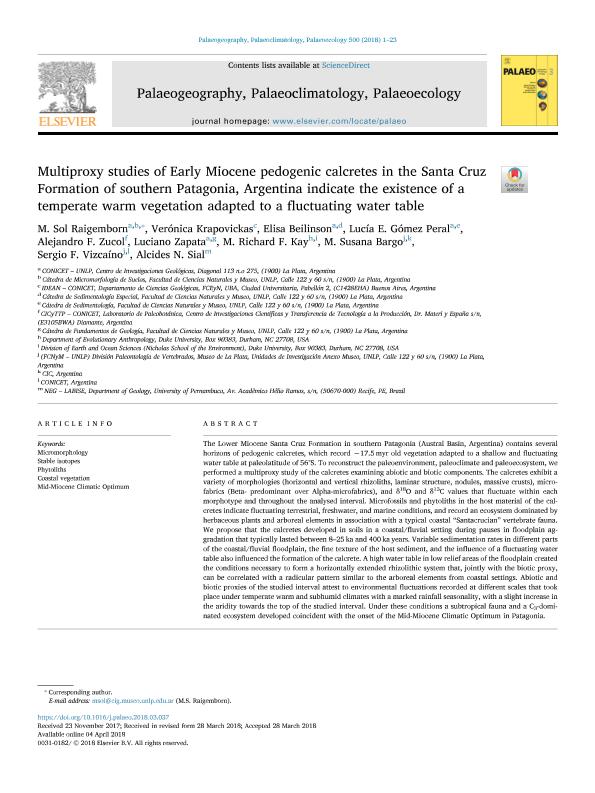Mostrar el registro sencillo del ítem
dc.contributor.author
Raigemborn, María Sol

dc.contributor.author
Krapovickas, Verónica

dc.contributor.author
Beilinson, Elisa

dc.contributor.author
Gómez Peral, Lucia

dc.contributor.author
Zucol, Alejandro Fabián

dc.contributor.author
Zapata, Luciano

dc.contributor.author
Kay, M. Richard F.
dc.contributor.author
Bargo, María Susana

dc.contributor.author
Vizcaíno, Sergio Fabián

dc.contributor.author
Sial, Alcides N.
dc.date.available
2019-07-24T15:14:07Z
dc.date.issued
2018-07
dc.identifier.citation
Raigemborn, María Sol; Krapovickas, Verónica; Beilinson, Elisa; Gómez Peral, Lucia; Zucol, Alejandro Fabián; et al.; Multiproxy studies of Early Miocene pedogenic calcretes in the Santa Cruz Formation of southern Patagonia, Argentina indicate the existence of a temperate warm vegetation adapted to a fluctuating water table; Elsevier Science; Palaeogeography, Palaeoclimatology, Palaeoecology; 500; 7-2018; 1-23
dc.identifier.issn
0031-0182
dc.identifier.uri
http://hdl.handle.net/11336/80147
dc.description.abstract
The Lower Miocene Santa Cruz Formation in southern Patagonia (Austral Basin, Argentina) contains several horizons of pedogenic calcretes, which record −17.5 myr old vegetation adapted to a shallow and fluctuating water table at paleolatitude of 56°S. To reconstruct the paleoenvironment, paleoclimate and paleoecosystem, we performed a multiproxy study of the calcretes examining abiotic and biotic components. The calcretes exhibit a variety of morphologies (horizontal and vertical rhizoliths, laminar structure, nodules, massive crusts), microfabrics (Beta- predominant over Alpha-microfabrics), and δ18O and δ13C values that fluctuate within each morphotype and throughout the analysed interval. Microfossils and phytoliths in the host material of the calcretes indicate fluctuating terrestrial, freshwater, and marine conditions, and record an ecosystem dominated by herbaceous plants and arboreal elements in association with a typical coastal “Santacrucian” vertebrate fauna. We propose that the calcretes developed in soils in a coastal/fluvial setting during pauses in floodplain aggradation that typically lasted between 8–25 ka and 400 ka years. Variable sedimentation rates in different parts of the coastal/fluvial floodplain, the fine texture of the host sediment, and the influence of a fluctuating water table also influenced the formation of the calcrete. A high water table in low relief areas of the floodplain created the conditions necessary to form a horizontally extended rhizolithic system that, jointly with the biotic proxy, can be correlated with a radicular pattern similar to the arboreal elements from coastal settings. Abiotic and biotic proxies of the studied interval attest to environmental fluctuations recorded at different scales that took place under temperate warm and subhumid climates with a marked rainfall seasonality, with a slight increase in the aridity towards the top of the studied interval. Under these conditions a subtropical fauna and a C3-dominated ecosystem developed coincident with the onset of the Mid-Miocene Climatic Optimum in Patagonia.
dc.format
application/pdf
dc.language.iso
eng
dc.publisher
Elsevier Science

dc.rights
info:eu-repo/semantics/openAccess
dc.rights.uri
https://creativecommons.org/licenses/by-nc-sa/2.5/ar/
dc.subject
Coastal Vegetation
dc.subject
Micromorphology
dc.subject
Mid-Miocene Climatic Optimum
dc.subject
Phytoliths
dc.subject
Stable Isotopes
dc.subject.classification
Paleontología

dc.subject.classification
Ciencias de la Tierra y relacionadas con el Medio Ambiente

dc.subject.classification
CIENCIAS NATURALES Y EXACTAS

dc.title
Multiproxy studies of Early Miocene pedogenic calcretes in the Santa Cruz Formation of southern Patagonia, Argentina indicate the existence of a temperate warm vegetation adapted to a fluctuating water table
dc.type
info:eu-repo/semantics/article
dc.type
info:ar-repo/semantics/artículo
dc.type
info:eu-repo/semantics/publishedVersion
dc.date.updated
2019-07-23T13:00:49Z
dc.journal.volume
500
dc.journal.pagination
1-23
dc.journal.pais
Países Bajos

dc.journal.ciudad
Amsterdam
dc.description.fil
Fil: Raigemborn, María Sol. Consejo Nacional de Investigaciones Científicas y Técnicas. Centro Científico Tecnológico Conicet - La Plata. Centro de Investigaciones Geológicas. Universidad Nacional de La Plata. Facultad de Ciencias Naturales y Museo. Centro de Investigaciones Geológicas; Argentina. Universidad Nacional de La Plata. Facultad de Ciencias Naturales y Museo; Argentina
dc.description.fil
Fil: Krapovickas, Verónica. Consejo Nacional de Investigaciones Científicas y Técnicas. Oficina de Coordinación Administrativa Ciudad Universitaria. Instituto de Estudios Andinos "Don Pablo Groeber". Universidad de Buenos Aires. Facultad de Ciencias Exactas y Naturales. Instituto de Estudios Andinos "Don Pablo Groeber"; Argentina
dc.description.fil
Fil: Beilinson, Elisa. Consejo Nacional de Investigaciones Científicas y Técnicas. Centro Científico Tecnológico Conicet - La Plata. Centro de Investigaciones Geológicas. Universidad Nacional de La Plata. Facultad de Ciencias Naturales y Museo. Centro de Investigaciones Geológicas; Argentina. Universidad Nacional de La Plata. Facultad de Ciencias Naturales y Museo; Argentina
dc.description.fil
Fil: Gómez Peral, Lucia. Consejo Nacional de Investigaciones Científicas y Técnicas. Centro Científico Tecnológico Conicet - La Plata. Centro de Investigaciones Geológicas. Universidad Nacional de La Plata. Facultad de Ciencias Naturales y Museo. Centro de Investigaciones Geológicas; Argentina. Universidad Nacional de La Plata. Facultad de Ciencias Naturales y Museo; Argentina
dc.description.fil
Fil: Zucol, Alejandro Fabián. Provincia de Entre Ríos. Centro de Investigaciones Científicas y Transferencia de Tecnología a la Producción. Universidad Autónoma de Entre Ríos. Centro de Investigaciones Científicas y Transferencia de Tecnología a la Producción. Consejo Nacional de Investigaciones Científicas y Técnicas. Centro Científico Tecnológico Conicet - Santa Fe. Centro de Investigaciones Científicas y Transferencia de Tecnología a la Producción; Argentina
dc.description.fil
Fil: Zapata, Luciano. Consejo Nacional de Investigaciones Científicas y Técnicas. Centro Científico Tecnológico Conicet - La Plata. Centro de Investigaciones Geológicas. Universidad Nacional de La Plata. Facultad de Ciencias Naturales y Museo. Centro de Investigaciones Geológicas; Argentina. Universidad Nacional de La Plata. Facultad de Ciencias Naturales y Museo; Argentina
dc.description.fil
Fil: Kay, M. Richard F.. Duke University; Estados Unidos
dc.description.fil
Fil: Bargo, María Susana. Universidad Nacional de La Plata. Facultad de Ciencias Naturales y Museo. División Paleontología Vertebrados; Argentina. Provincia de Buenos Aires. Gobernación. Comisión de Investigaciones Científicas; Argentina
dc.description.fil
Fil: Vizcaíno, Sergio Fabián. Consejo Nacional de Investigaciones Científicas y Técnicas; Argentina. Universidad Nacional de La Plata. Facultad de Ciencias Naturales y Museo. División Paleontología Vertebrados; Argentina
dc.description.fil
Fil: Sial, Alcides N.. University of Pernambuc; Brasil
dc.journal.title
Palaeogeography, Palaeoclimatology, Palaeoecology

dc.relation.alternativeid
info:eu-repo/semantics/altIdentifier/url/https://www.sciencedirect.com/science/article/pii/S0031018217311501
dc.relation.alternativeid
info:eu-repo/semantics/altIdentifier/doi/https://doi.org/10.1016/j.palaeo.2018.03.037
Archivos asociados
